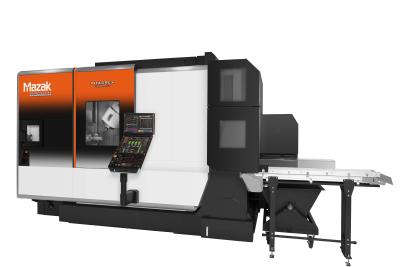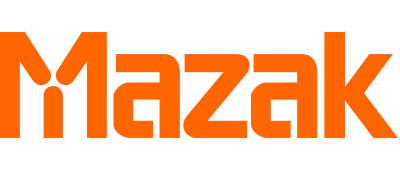
At its February 23 broadcast of All Axes LIVE, an online event series, Mazak continued the roll-out of its new i-H Series of machines with a demonstration of the productivity-boosting INTEGREX i-200H ST Multi-Tasking Machine. Like other INTEGREX i-H Series machines, the INTEGREX i-200H ST features a new design that increases flexibility and enhances machine performance for significantly easier automation integration, allowing shops to boost the output of their existing workforces with the utmost in cost efficiency.
Mazak designed its new INTEGREX i-H Series machines with the flexibility necessary to process a practically endless variety of part types without additional capital expenses. The new machines allow shops to add a multitude of automation options – some of which are retrofittable in the field – as production levels dictate long after the initial purchase of the machine, ensuring easy access to continuous improvement.
The machines within the i-H Series sport new, ergonomic enclosures with compact footprints that require less floor space. In addition, Mazak equipped the machines with faster and more powerful turning spindles, space-saving milling spindles and a new parallel-type lower turret with optional live tooling capabilities. The company also expanded tool capacities for lower turrets and for tool storage magazines along with offering a wider range of chuck size options.
Specific INTEGREX i-200H ST machine changes that ease the integration of automation are the inclusion of front and rear tool setup, a flat-front design to accommodate robots, tool magazine placement at the machine’s rear side and an easily retrofittable automatic machine door. Other new additions that make for easy machine automation are an integrated automatic jaw changer (AJC) and the parallel-type lower turrets.
Requiring no additional robot system and without interrupting machine operation, the AJC quickly exchanges jaws from turning spindle chucks with others in jaw stocker systems located above both of the machine’s turning spindles. These stocker systems have room for up to 10 jaw sets that can be loaded/unloaded while the machine continues to work uninterrupted.
Along with a parallel-type turret (T), the INTEGREX i-200H ST sports both a main and second turning spindle (S) and a milling spindle headstock for DONE IN ONEÒ part production. The new turret design not only works with a greater range of tool lengths, but also eliminates interference when workpieces are held between the machine’s two turning spindles and reduces chip accumulation on the machine’s X-axis covers.
The INTEGREX i-200H ST accommodates a chuck size of 8” and boasts a new extended Y-axis stroke of 8.27" and X-axis stroke of 21.06" for maximum part diameters of 23.62". The main and second turning spindles operate at 5,000 rpm, while the milling spindle comes standard as 12,000 rpm (24/22 kW), with a 20,000 rpm (24/22 kW) version offered as an option.
The INTEGREX i-200H ST also uses the latest Mazak control technology, the MAZATROL SmoothAi CNC. For fully optimized machining operations, the AI-powered technologies within the new MAZATROL SmoothAi control make for fast and easy programming, controlled spindle speed for reduced vibration and greater machine thermal stability. These Mazak technologies include Solid MAZATROL, which allows users to automatically generate programs from 3D part models; SMOOTH Ai Spindle, which automatically optimizes spindle speed based on sensor feedback to minimize machining vibration for superior part surface finishes; and Ai Thermal Shield, which adapts to and learns from environmental changes to control the effects of heat on machining accuracy.
In addition to new SMOOTH TECHNOLOGY solutions and control functions, the new control also provides access to Mazak’s MAZATROL TWINS software, which allows shops to create, on a PC, synchronized digital twins of real machines on their shop floors. The digital twins software solutions provide highly efficient machine operation through SMOOTH Project Manager that ensures efficient job setups and SMOOTH CAM Ai for an open and interactive interface for CAD/CAM software packages.
Contact Details
Related Glossary Terms
- chuck
chuck
Workholding device that affixes to a mill, lathe or drill-press spindle. It holds a tool or workpiece by one end, allowing it to be rotated. May also be fitted to the machine table to hold a workpiece. Two or more adjustable jaws actually hold the tool or part. May be actuated manually, pneumatically, hydraulically or electrically. See collet.
- computer numerical control ( CNC)
computer numerical control ( CNC)
Microprocessor-based controller dedicated to a machine tool that permits the creation or modification of parts. Programmed numerical control activates the machine’s servos and spindle drives and controls the various machining operations. See DNC, direct numerical control; NC, numerical control.
- computer-aided manufacturing ( CAM)
computer-aided manufacturing ( CAM)
Use of computers to control machining and manufacturing processes.
- gang cutting ( milling)
gang cutting ( milling)
Machining with several cutters mounted on a single arbor, generally for simultaneous cutting.
- milling
milling
Machining operation in which metal or other material is removed by applying power to a rotating cutter. In vertical milling, the cutting tool is mounted vertically on the spindle. In horizontal milling, the cutting tool is mounted horizontally, either directly on the spindle or on an arbor. Horizontal milling is further broken down into conventional milling, where the cutter rotates opposite the direction of feed, or “up” into the workpiece; and climb milling, where the cutter rotates in the direction of feed, or “down” into the workpiece. Milling operations include plane or surface milling, endmilling, facemilling, angle milling, form milling and profiling.
- turning
turning
Workpiece is held in a chuck, mounted on a face plate or secured between centers and rotated while a cutting tool, normally a single-point tool, is fed into it along its periphery or across its end or face. Takes the form of straight turning (cutting along the periphery of the workpiece); taper turning (creating a taper); step turning (turning different-size diameters on the same work); chamfering (beveling an edge or shoulder); facing (cutting on an end); turning threads (usually external but can be internal); roughing (high-volume metal removal); and finishing (final light cuts). Performed on lathes, turning centers, chucking machines, automatic screw machines and similar machines.

